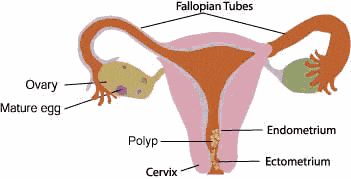|


WHAT IS A CERVICAL POLYP?
Small, fleshy, fragile, bulbous growths with a stalk
arising from the lining inside the uterus and protruding through the
cervix (picture above).
They may be single or multiple.
AFFECTS
All ages but more common in childbearing age.
SIGNS & SYMPTOMS
- Unexpected spotting of blood in-between menstrual
periods.
- Spotting of blood after sexual intercourse or bowel
movements.
- Vaginal discharge – mostly white but may be blood
tinged or foul smelling.
CAUSES
Cervical polyps are caused by
cervix inflammation from
infection, erosion or ulceration. They frequently accompany
chronic infections in the vagina or
cervix, although they are not contagious. The small
growths are usually benign, but in very rare cases, they represent early cancer of the cervix.
RISK INCREASES WITH
- Diabetes mellitus.
- Recurrent vaginitis or cervicitis.
HOW TO PREVENT
To prevent infections of vagina or
cervix that can
precede cervical polyps:
- Wear cotton panties to prevent accumulation of excess heat
and moisture, which can make you susceptible to vaginal and cervical infections. Avoid
panties made from non-ventilating materials.
- Avoid contracting gonorrhea or
other sexually transmitted diseases by having single partner
and safe sex practices.
DIAGNOSTIC MEASURES
- Suggestive symptoms.
- History and physical exam by a doctor.
- Laboratory studies, such as a Pap smear and examination of the vaginal discharge.
POSSIBLE COMPLICATIONS
None expected, but in very rare instances, cervical
polyps may become malignant.
PROBABLE OUTCOME
Usually curable with surgery. One may feel brief, mild
pain during the procedure and have mild to moderate cramps for several hours. Spotting of
blood from the vagina may occur for 1 or 2 days.
TREATMENT
GENERAL MEASURES
- Use small sanitary pads to protect your clothing from
creams or suppositories.
- Keep creams or suppositories in the refrigerator, to
prevent melting in our climate.
- Cervical polyps are removed either with a wire snare, electrocautery or cryocautery (liquid
nitrogen). This is often be done on an outpatient basis. Discuss with your doctor,
cauterization of the
cervix after removing the polyp to prevent regrowth.
- A polyp that accompanies cervicitis
(inflammation or infection of the
cervix) may require more extensive surgery.
MEDICATION
You may be prescribed antibiotics either orally or in
vaginal suppositories or creams to fight infection.
ACTIVITY
No restrictions. Delay sexual relations until your doctor
determines that healing is complete on a follow-up pelvic exam.
DIET
No special diet.
CONTACT YOUR DOCTOR IMMEDIATELY, IF
- You have suggestive symptoms.
- The following occur after treatment:
- Discomfort persists longer than 1 week.
- Symptoms recur.
- Unexplained vaginal bleeding or swelling develops.
- New, unexplained symptoms develop.
- Drugs used in treatment may produce side effects.
|
